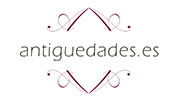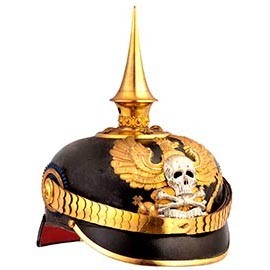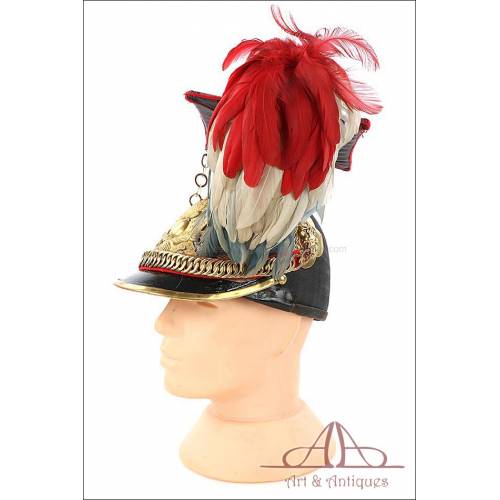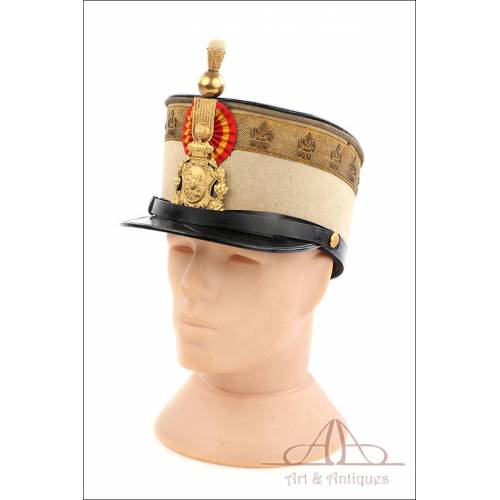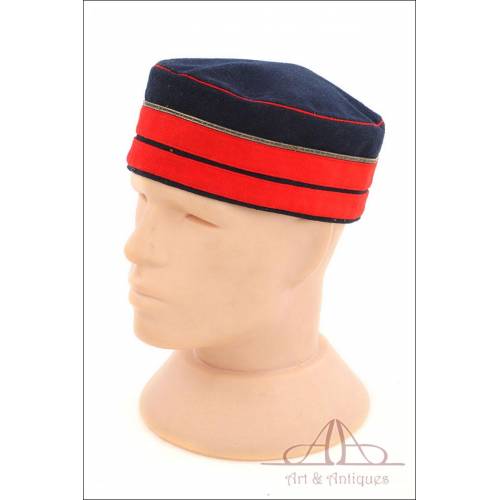Antique Military Helmets
Within military antiques, antique helmets are a very special sector. Their imposing presence is joined by their historical importance, which gives them an added value that few period pieces can generate. Until the appearance of firearms, helmets were a fundamental element in the protection of soldiers. From that moment on, although they retaine...
Within military antiques, antique helmets are a very special sector. Their imposing presence is joined by their historical importance, which gives them an added value that few period pieces can generate. Until the appearance of firearms, helmets were a fundamental element in the protection of soldiers. From that moment on, although they retained their protective capacity, this function was to some extent relegated to the background.
Helmets have been a fundamental part of the equipment of soldiers and warriors since Antiquity. Legend has it that the only soldiers who did not wear helmets during combat were Celtic warriors; however, some pieces found in excavations seem to disprove this myth. In any case, the enormous variety of ancient helmets, their beauty and quality make them worthy of a place in our collection of war antiques.
Brief history of the antique helmets
Since the discovery of metal in prehistoric times, men have forged helmets to protect themselves during combat. Helmets have been found from Mesopotamian civilizations (Akkadians and Sumerians), dated to the 23rd century BC, as well as pieces from Mycenaean Greece (17th century BC) and helmets forged by the Assyrians (900 BC). In early times they were made of copper and leather, but with the evolution of metalworking, other more resistant materials, such as bronze and iron, began to be used. Around 950, some societies began to use forged steel in the construction of weapons and helmets. In those times, helmets had a purely military use and usually covered the skull and part of the warrior's face.
Over time the designs evolved and changed, with the appearance of magnificent pieces such as Japanese helmets, armor helmets or Spanish morriones. In the 17th century the military use of ancient helmets began to decline; in fact, in the early 18th century, infantrymen in many armies stopped wearing helmets. However, from 1789 onwards, the Napoleonic army resumed their use in its cavalry corps. The use of artillery during World War I renewed the need to incorporate steel helmets into soldiers' uniforms to protect them from shrapnel. In this regard, the first modern steel helmets are the Adrian of the French Army and the Brodie of the British Army. Another well-known early helmet is the German Stahlhelm, introduced in 1916 to replace the famous Prussian Pickelhaube (pointed helmet used by the German army during the 19th century). All these models were also employed during World War II.
Types of antique helmets
Greek helmets. Precursors in design of the Romans, they were characterized by the protections worn over the nose and cheeks. The most famous is the Corinthian helmet.
Roman helmets Employed by the armies of Ancient Rome, there are different types such as the montefortine, the coolus, the Gallic-imperial, the Italic, the centurion (with transverse plume, from ear to ear) and the tribune or legionary (with longitudinal plume, from nape to forehead).
Medieval helmets . During the Middle Ages many types of ancient helmets were developed. All of them covered practically the entire head and face, with mesh or visors that allowed better mobility. Among them we can highlight the helmet, the barbute, the celada, the morrion, the capelina, the bacinete...
Japanese helmets . The traditional ancient helmet of Japanese armor is called kabuto. The oldest date back to the 5th century, being later incorporated into the uniform of the samurai. They are very elaborate and ornamental.
In addition to helmets, military uniforms in many cases incorporate all kinds of hats and headgear that complement military attire. Some of the best known are as follows:
Bicorns . Also known as a "two-cornered hat", the bicorn is a military headdress created for the French army from 1790. It is the hat with which Napoleon Bonaparte was usually depicted. This model (frontal) had the tips facing outwards, but from 1810 it was changed to the "costal" design, with the tips on the forehead and the nape of the neck. The costal bicorn was very popular in Latin America, being used by figures such as the Argentine José San Martín or the Venezuelan Simón Bolívar.
Antique military caps. The caps are characterized by having a front visor attached to the body of the headdress. There are different types: plate caps, quepis, ros or the Russian budionovka,among others.
Antique military berets . Berets exert a non-protective, practical and differentiating function. Celtic armies began to incorporate them in the twelfth century. In Spain they were widely used during the Carlist Wars (where they indicated military rank according to color). In the Civil War, Franco's army included the red beret as part of its equipment. Today there are many armies that incorporate berets in the uniforms of different sections.
The sheer variety of antique helmets and military headgear in existence makes collecting these items an exciting hobby. Present in historical and military museums around the world, period helmets and headgear are pieces of enormous drawing power.
Antique French Chapska Helmet for Lancer officer. Mod. 1848. France, Circa 1850 Antique French Chapska Helmet...
Superb chapska helmet for Lancer Officer in very good condition. With original ancient plume. Superb chapska helmet for Lancer...
SoldAntique Shako for Infantry Officer. Model 1908. Spain circa 1915 Antique Shako for Infantry...
Authentic Spanish military cap for infantry officers from the time of king Alphonse 13th. In amazing condition. Authentic Spanish military cap for...
SoldAntique Spanish Barracks Cap. Reign of King Alphonse 13th Antique Spanish Barracks Cap....
Military barrack cap used during the reign of Alphonse 13th in Spain. In fine condition. Military barrack cap used during the...
Sold
New products
-

Antique ivory and silver plated stethoscope, late 19th century
Antique stethoscope from the late 19th century in silver-plated metal...
-

Vintage pendant with shell cameo of Jesús del Gran Poder, carved c. 1970
Vintage pendant with a shell-carved cameo of Jesus del Gran Poder, circa...
-

Antique Roman Style Gilded Silver Chalice with Paten. France, 1932
Antique Roman-style chalice in gilded silver with paten. France, 1932....
-

Beautiful Antique 18 K Gold Ring with 7 Natural Diamonds
Antique 18K gold ring with 7 natural diamonds. Delicate openwork design,...
-

Antique Silver Reliquary. José Vilaplana. Valencia, Spain. Circa 1920
Impressive repoussé silver reliquary by José Vilaplana, Valencia, c....
-

Vintage 18K Gold Ring with 7 Natural Diamonds
Vintage 18K gold ring with seven natural diamonds in floral setting....
-

Antique Silver Chalice. Enameled Crosses. Valencia, Spain, 1942
Spanish chalice from 1942 in solid silver, gifted by the Church of...
-

Antique Silver Chalice and Paten. Granada Spain, circa 1900
Spanish chalice in white silver with matching paten, handcrafted....
Specials
-

Complete Silver Art Deco Flatware Set for 12. Barcelona, Circa 1920
Gorgeous complete silver Art Deco...
